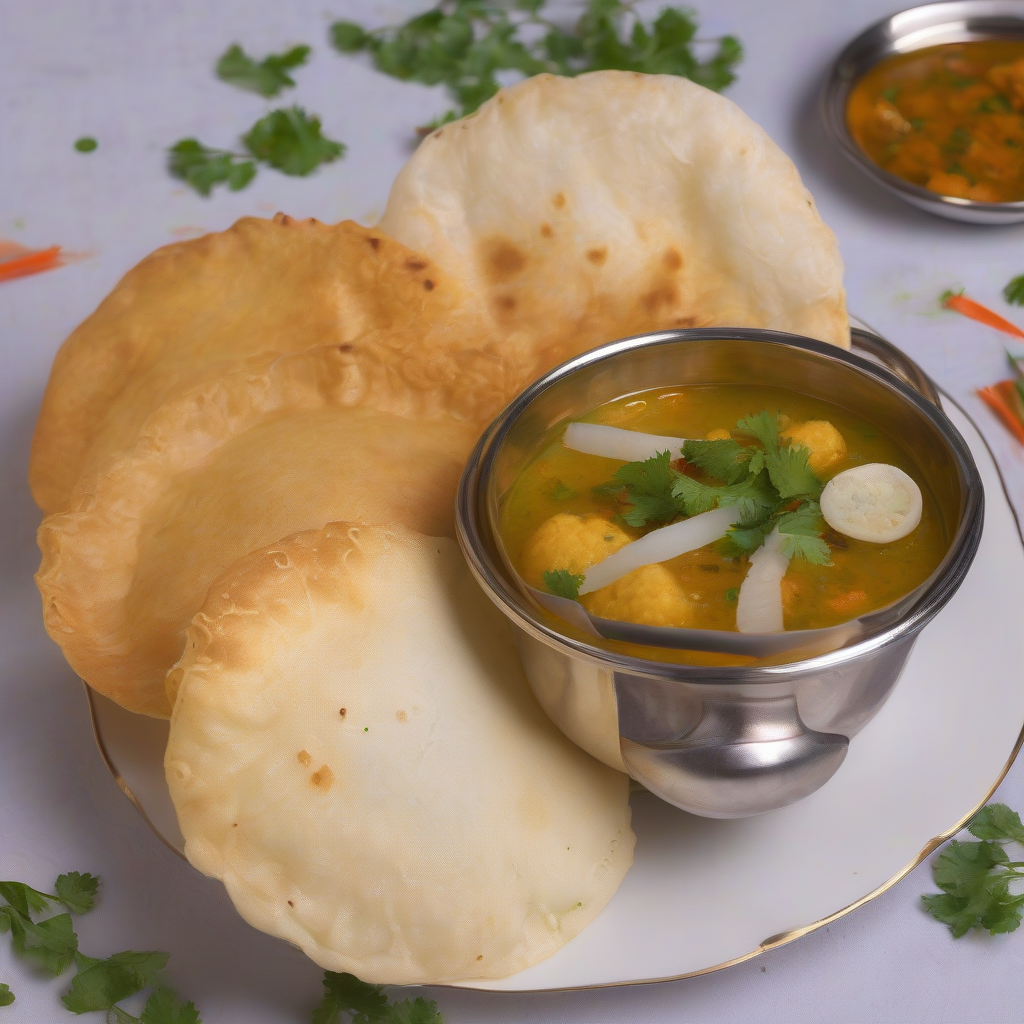Kya Baat Hai! Crispy Pooris and Chatpata Poriyal: A Match Made in Heaven!
Namaste, and Vanakkam my dear food-loving friends! Chef Curry Do’pyaza here, ready to whisk you away on another delicious culinary adventure. Today, we are diving headfirst into a classic South Indian comfort food combo: Poori and Poriyal!
This dish is more than just food; it’s a warm hug on a plate. It’s the taste of home, the memory of grandma’s kitchen, and the joy of sharing a simple, delicious meal with loved ones.
Occasions for Celebration!
In many South Indian homes, especially in Tamil Nadu and Kerala, Poori and Poriyal are a staple during festivals like Pongal, Diwali, and even simple family gatherings. It’s a breakfast favorite, a quick lunch option, and sometimes even a light dinner. Think of it as the Indian equivalent of biscuits and gravy, but with a whole lot more spice and sunshine! The dish is especially popular during the summer months.
A Little History Lesson
Poori, the fluffy fried bread, has been around for centuries. It’s believed to have originated in North India and gradually made its way down South. Poriyal, on the other hand, is a quintessential South Indian dish. It’s a dry vegetable stir-fry, bursting with flavor from mustard seeds, curry leaves, and a generous dose of spices. The combination of the light, airy poori with the savory, spiced poriyal is a culinary masterpiece!
Let’s Get Cooking!
Preparation Time: 20 minutes
Cooking Time: 30 minutes
Ingredients:
For the Poori:
- 2 cups Gehun ka Atta (Whole Wheat Flour)
- 1 tablespoon Sooji (Semolina) – this makes them extra crispy!
- 1 teaspoon Ajwain (Carom Seeds) – for digestion and flavor
- 1 tablespoon Tel (Vegetable Oil)
- Salt to taste
- Water, as needed
- Tel (Vegetable Oil), for deep frying
For the Poriyal (Cabbage Version):
- 2 cups Patta Gobi (Shredded Cabbage)
- 1 tablespoon Tel (Vegetable Oil)
- 1 teaspoon Rai (Mustard Seeds)
- 1 teaspoon Urad Dal (Split Black Gram)
- 1/2 teaspoon Chana Dal (Split Chickpea Lentil)
- 2 Sukhi Lal Mirch (Dry Red Chilies), broken into pieces
- 1 sprig Curry Patta (Curry Leaves)
- 1/4 teaspoon Haldi Powder (Turmeric Powder)
- Salt to taste
- 2 tablespoons fresh Nariyal (Grated Coconut)
Step-by-Step Instructions:
Making the Poori:
- In a large bowl, combine the Gehun ka Atta, Sooji, Ajwain, Tel, and salt.
- Gradually add water, kneading to form a stiff, but pliable dough. It should not be sticky!
- Cover the dough with a damp cloth and let it rest for at least 15 minutes. This is crucial for soft, puffy pooris.
- Divide the dough into small, equal-sized balls.
- On a lightly floured surface, roll each ball into a small, circular disc, about 3-4 inches in diameter. Don’t make them too thin!
- Heat Tel in a deep frying pan or Kadai over medium-high heat. The Tel should be hot enough that a small piece of dough dropped in immediately sizzles and floats to the top.
- Gently slide a poori into the hot Tel. Using a slotted spoon, gently press down on the poori. It should puff up beautifully!
- Fry the poori until golden brown on both sides.
- Remove the poori from the Tel and drain on paper towels.
- Repeat with the remaining dough balls.
Making the Poriyal:
- Heat Tel in a pan over medium heat.
- Add Rai. When they splutter, add Urad Dal and Chana Dal. Fry until golden brown.
- Add Sukhi Lal Mirch and Curry Patta. Sauté for a few seconds.
- Add the shredded Patta Gobi and Haldi Powder. Stir well.
- Add salt to taste.
- Cover the pan and cook until the Patta Gobi is tender, about 8-10 minutes, stirring occasionally.
- Stir in the fresh Nariyal. Cook for another minute.
- Remove from heat and serve hot with the Pooris.
Chef Curry’s Tips for the Perfect Poori & Poriyal:
- Poori Tip: The dough should be stiff, not sticky. Resting the dough is key for soft pooris. Make sure the oil is hot enough, but not smoking.
- Poriyal Tip: Don’t overcook the cabbage. It should still have a slight crunch. Adjust the amount of red chilies to your spice preference.
Cooking Variations:
- Gas Stove: The traditional method, perfect for achieving that authentic flavor.
- Induction Stove: Works just as well as a gas stove. Adjust the heat settings accordingly.
- Pressure Cooker (for Poriyal): You can pressure cook the cabbage for 1 whistle for a faster cooking time. Be careful not to overcook it!
- Air Fryer (for Poori): While not traditional, you can brush the pooris with oil and air fry them at 375°F (190°C) for a healthier option. They won’t puff up as much, but they’ll still be tasty.
- Microwave (for Poriyal): Not recommended, as the cabbage will become soggy.
Nutritional Information (Approximate):
- Poori (1 piece): 120 calories, 6g fat, 15g carbohydrates, 3g protein
- Poriyal (1/2 cup): 80 calories, 4g fat, 8g carbohydrates, 2g protein
These values are approximate and can vary depending on the specific ingredients and cooking methods used.
Serving Suggestions:
- Serve the hot, puffed-up Pooris immediately with the flavorful Poriyal.
- A dollop of plain yogurt or a spoonful of pickle adds a tangy twist.
- A cup of hot chai or coffee completes the perfect meal.
Time to Cook!
So there you have it, folks! A simple, yet incredibly satisfying recipe for Poori and Poriyal. I urge you to try this at home and share it with your family and friends. Trust me, they’ll be thanking you for it! Happy cooking!
